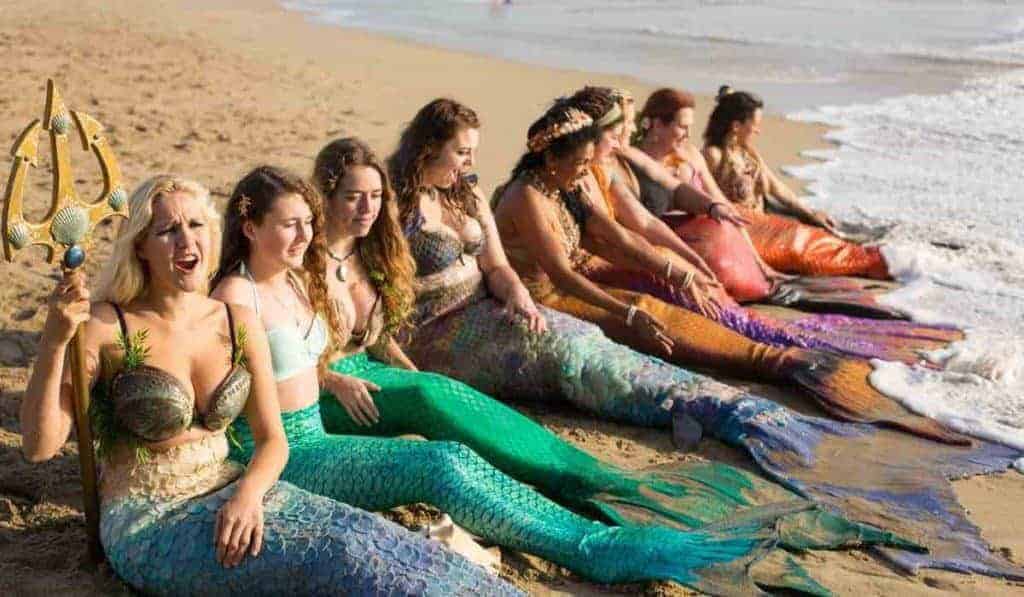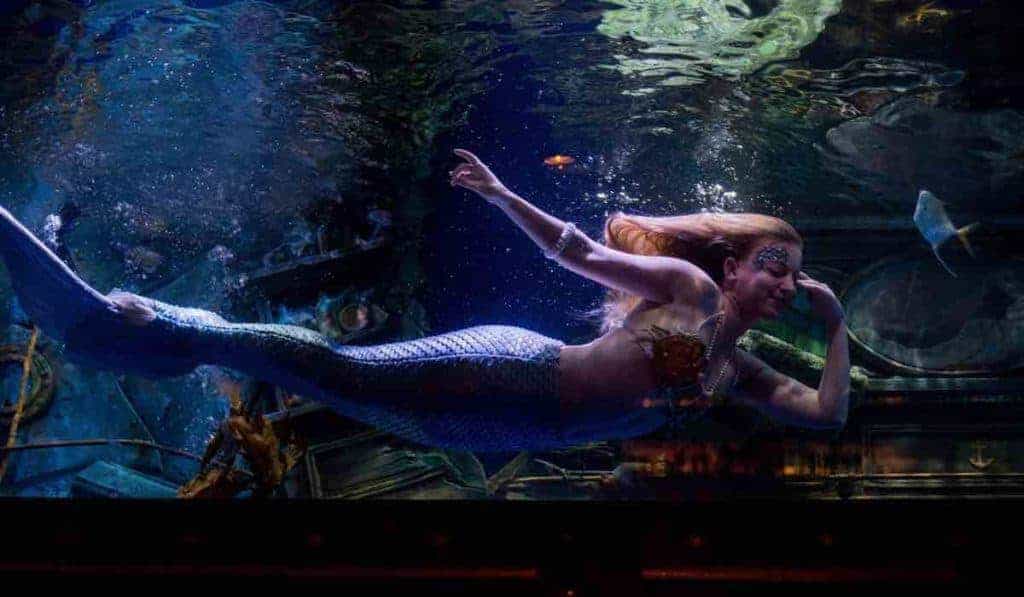Canadian filmmaker Ali Weinstein explores how putting on a mermaid tail can help women transform into mystical powerful beings in Mermaids. For tickets and more information, visit the HotDocs website here.

This year’s HotDocs features several quirky docs about very niche subcultures in society. Shiners examines shoe shiners’ love of their profession from around the world. Tokyo Idols introduces us to the unhealthily obsessed middle-aged male fans of Japan’s “idols”, young sugar pop stars who look like cartoon representations of female beauty. In Mermaids, Canadian filmmaker Ali Weinstein dives into a community of American women who like to dress up as mermaids.
I was hesitant to cover Mermaids: I have an aversion to water, and I thought this documentary would be all surface silliness. However, by the end of the documentary, I was tearing up because of the life struggles the subjects went through. This film explores how putting on a mermaid tail can help these women transform into mystical powerful beings, making them feel stronger and better about themselves.
I talked to Weinstein about her vision for the film and how she got fascinated with mermaids and the women who love them.
The Seventh Row (7R): What drew you to making a documentary about mermaids?
Ali Weinstein (AW): I learned about this mermaid theme park in Florida, Weeki Wachee. It’s been around since 1947. I read a New York Times Magazine article in 2014 where they interviewed women who worked there in the 1950s, 1960s, and 1970s. They all spoke about their job being a mermaid as if it were the most transformative experience in their lives.
That got me thinking how interesting it would be to do a study about what it means to escape into this alter ego by putting on a tail — in particular, to become a mermaid, to be universally loved. I related a little bit, too, because I was obsessed with mermaids as a kid. I became a synchronized swimmer and spent a lot of my life in the water as a teenager. I understood that magic of being a mermaid in the water and feeling as if you were really in a different world. I had to put on a tail myself at that point [in researching the film], and I was curious about learning more about that.
[clickToTweet tweet=”Ali Weinstein wanted to study what it means to escape into this alter ego by putting on a tail.” quote=”Weinstein wanted to ‘study what it means to escape into this alter ego by putting on a tail — in particular, to become a mermaid, to be universally loved.'”]
7R: How did you find the subjects in the film?
AW: I went to Weeki Wachee, back in the summer of 2014, and met some of the women who were in the film. I met Vicky there, one of the legendary sirens who is our oldest [performer] in the film at 76. My producer, Caitlyn Durlak, and I went to MerFEST in 2015, which is a mermaid conference in North Carolina. We met most of our other subjects there. We met Cookie and Ralph, who get married in the film, and Julz. We met Rachel and Amanda, as well.
Read more: HotDocs Interview: Director Ann Shin on the making of My Enemy, My Brother >>
7R: There were some beautiful images of mermaids underwater with voice overs of mythological stories surrounding the mermaid character. How did you create those sequences with your Director of Photography (DOP), Catherine Lutes?
AW: I was really interested in mermaid mythology. I was researching the real people who are in my film, I was also researching the different mythologies that exist from all around the world. I was really blown away by how universal it is, how global it is.
There are so many mermaid myths everywhere. They all share certain connections about being very feminist and showing a very powerful woman — but also a woman who has experienced suffering. [The mermaid] is a very complex character. It was important for me to try to show some of that, as well as [to] tell the stories of our main characters.
[clickToTweet tweet=”‘There are so many mermaid myths about a powerful woman who has experienced suffering.'” quote=”There are so many mermaid myths…about being very feminist and a powerful woman who has experienced suffering.”]
My editor, producer, and I [decided a lot] through experimentation. [We tried] to represent some of these mermaid myths and lead to a bigger mythology beyond the lived experiences of the stars of our film. We went on several shoots, in all different locations, where our main subjects of the film were living. In each of those locations, we made sure to do some underwater shooting with them.
[We would] superimpose different water imagery over each other to create a more mythical texture. Most of the footage within the myth section, we shot in Hawaii. We were luckily enough to shoot out in the open ocean. Our cinematographer did an incredible job. She had never done that much underwater shooting before. She picked it up really quickly. We also hired some deep sea divers who are photographers. They were able to stay underwater for a very long time and get these long, epic shots from deep.

7R: The score was particularly enchanting and captured the feeling of being an underwater creature. Can you discuss your artistic decisions surrounding the mesmerizing score of the film?
AW: We worked with composers Justin Small and Ohad Benchetrit, who have worked on a lot of documentaries before. They are both incredible musicians. I have to give them a lot of credit. They watched the film in its rough cut stage. We talked a lot about trying to create something that felt watery and fluid — but at the same time not cliched. [We wanted] to have some of the references to mermaids — certain sounds and a little bit of vocals to seem like Ariel — but subtle enough so it’s not in your face.
Read more: HotDocs Interview: Director Stacey Tenenbaum on elevating the shoe shining profession in Shiners >>
7R: Your film draws a direct parallel between transforming into a mermaid by putting on the tail as well as undergoing the transition as a transgender person. Why was it important to you to show that perspective in the film?
AW: Before Caitlyn and I went to MERFest just in the research phase I did happen upon several transgender mermaids who are part of the mermaid community. When we did got to MERfest we met Julz there and she was very open about her transition and mermaiding played into that transition. In terms of giving her a sense of community and a sense of escape from her everyday life. It was fortuitous to meet someone who could be a voice in the mermaid community.
[clickToTweet tweet=”‘For a lot of people who wear mermaid tails, there was a moment in their lives that was a catalyst.'” quote=”For a lot of people who wear mermaid tails, there was a moment in their lives that was a catalyst.”]
7R: I was surprised that you examined a more vulnerable side to the subjects since most of the film is quite light hearted. Why did you feel it was important to include some of their struggles?
AW: It quickly became clear to us, once we did go to MERfest, that for a lot of people who wear mermaid tails, there was a moment for them in their lives that was a catalyst. People had experienced rough times or certain life events. They wanted to do something for themselves and put a tail on.
[clickToTweet tweet=”‘Unlikely as that sounds, we saw that it was a form of therapy for a lot of people.’ – Weinstein” quote=”Unlikely as that sounds, we saw that it was a form of therapy for a lot of people.”]
Unlikely as that sounds, we saw that it was a form of therapy for a lot of people. It was important to include that, [and] not to have it be [just] this aesthetic thing or a surface thing. There is a much deeper connection to the idea of mermaids, and the impact of putting on a tail, for a lot of the people who do it. I felt like there wasn’t a choice to show that side of it. It might be surprising for people that there were darker things in our [subjects’] lives.
7R: What are you hoping people take away from the film?
AW: I really hope that people who watch have fun, laugh, and enjoy it. The film is playful and whimsical. I also hope that, by the end of the [film], they have felt the deeper meaning [that] putting on the tail has for subjects. It would make me so happy if people walked away feeling inspired because they are looking up at the screen at a group of women who have gone through some struggles yet have come out the other side feeling strong and beautiful.
Read the rest of our 2017 HotDocs coverage here.

